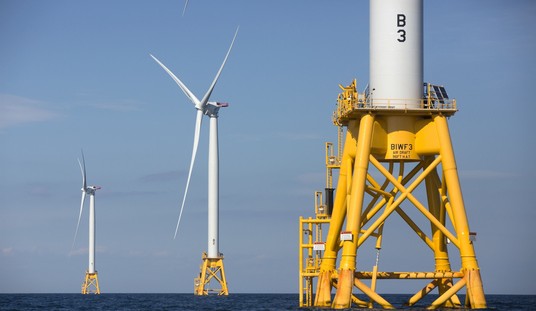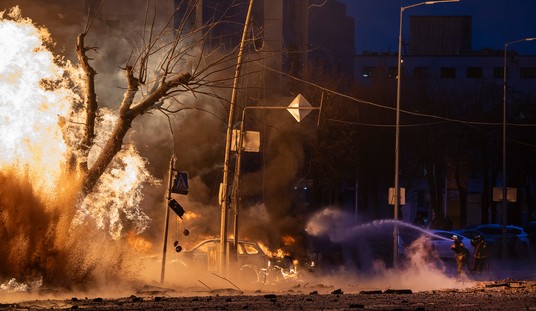In case you were too consumed with Ebola news yesterday to notice this, here’s a belated FYI that America’s going to put the Middle East’s oil barons out of business before your grandkids are out of college. Assuming the Ebola doesn’t get us first, I mean.
Lockheed has a webpage dedicated to its new breakthrough in compact fusion reactors but this write-up in Aviation Week is the most thorough explanation I’ve seen of how it would actually work. If I understand it correctly, which I probably don’t, the problem with current fusion reactors is that they’re too darned big and inefficient to be useful as power suppliers. To produce fusion, you inject a certain type of gas into the reactor, which heats it up. When the gas gets hot, the ions and electrons from the isotopes split apart and form a plasma; when it gets really hot, the ions recombine — fusion — releasing kinetic energy in the form of neutrons that collide with the reactor’s walls. The heat generated by those collisions is converted into electricity, and voila, you’ve got power. The trick is containing the plasma as it reaches fusion temperature so that it doesn’t touch the reactor’s walls, which would do damage. The containment is done by generating strong magnetic fields, but it takes biggggg magnets and lots of power to achieve that — so much power, in fact, that you end up putting in about as much as the reactor puts out, defeating the whole purpose. The traditional design of the fusion reactor, in which the plasma is encased in a big tube, is also sufficiently unstable that engineers typically use relatively small amounts of plasma compared to the huge magnetic field being generated. Also inefficient.
Lockheed claims to have solved all of that, theoretically, with a new design. Instead of using a little bit of plasma in a tube inside a larger reaction chamber, they’re going to fill the entire chamber with plasma and use coils of superconducting magnets to create the needed containment pressure. Lots more plasma means lots more energy potential, roughly 10 times as much as a traditional reactor, which means theoretically not only will the reactor produce way more power than it needs to operate it but it can operate on a much smaller scale than traditional reactors, around the size of a jet engine compared to the size of a building. That’s what they mean by a “compact fusion reactor.” It’s small enough to fit on a truck or, of course, a Navy carrier or Air Force plane and power them seemingly forever. If you believe Lockheed, one reactor would also be capable of powering a city of 100,000 people. The design is supposedly also safer than traditional reactors, not only because the pressure created by the superconducting magnetic coils is more stable and therefore better able to keep the plasma away from the reactor walls but because it requires only a few grams of radioactive tritium to operate. Bad guys would need to pilfer a lot of reactors to get some meaningful mass of tritium to use as a weapon. Meanwhile, each reactor would require only 55 lbs. of fuel, most of which could come from sea water. That 55 lbs. would produce 10 million times as much energy as 55 lbs. of fossil fuels. It would be perfectly clean too, with zero carbon emissions, which should make greens happy if they weren’t so invested in endless scaremongering about nuclear power.
Bottom line: It’s a dessert topping and a floor wax. But … does it work? All of this is merely theoretical; Lockheed thinks/hopes/expects that it’ll have a working model in 10 years, but is that true? Some scientists say, er, no.
First, fusion reactors right now are pretty big*. Mahajan says making them smaller is extremely hard to do—you need a very confined space, with loads of material at extremely high densities, and then you need to get that power out of the reactor to be used. “So it’s both the physics and the engineering which are extremely, extremely daunting,” he said. “We know of no materials that would be able to handle anywhere near that amount of heat.”
Mahajan called Lockheed’s announcement “poppycock.” He said, “Getting net energy from fusion is such a goddamn difficult undertaking,” he said. “We’re all aware that there’s always a finite chance of some breakthrough which is beyond the powers of imagination.” But if there was a genuine breakthrough, he said, “we’d be screaming from the treetops.”
One critic told Business Insider he expects Lockheed’s design will prove considerably worse in practice than a traditional fusion reactor. So why, if all of this is speculative, is Lockheed wetting itself with promo videos and webpages and heavy breathing exclusives to Aviation Week? You know why, silly: Money. “Lockheed Martin also announced that it’s looking for commercial partners to help fund the intervening years of research that will be required,” notes Ars Technica. “By making the developments sound inevitable, the company increases its chances of attracting someone to share the risk.” Public excitement now means more seed money. Who’s in?








Join the conversation as a VIP Member